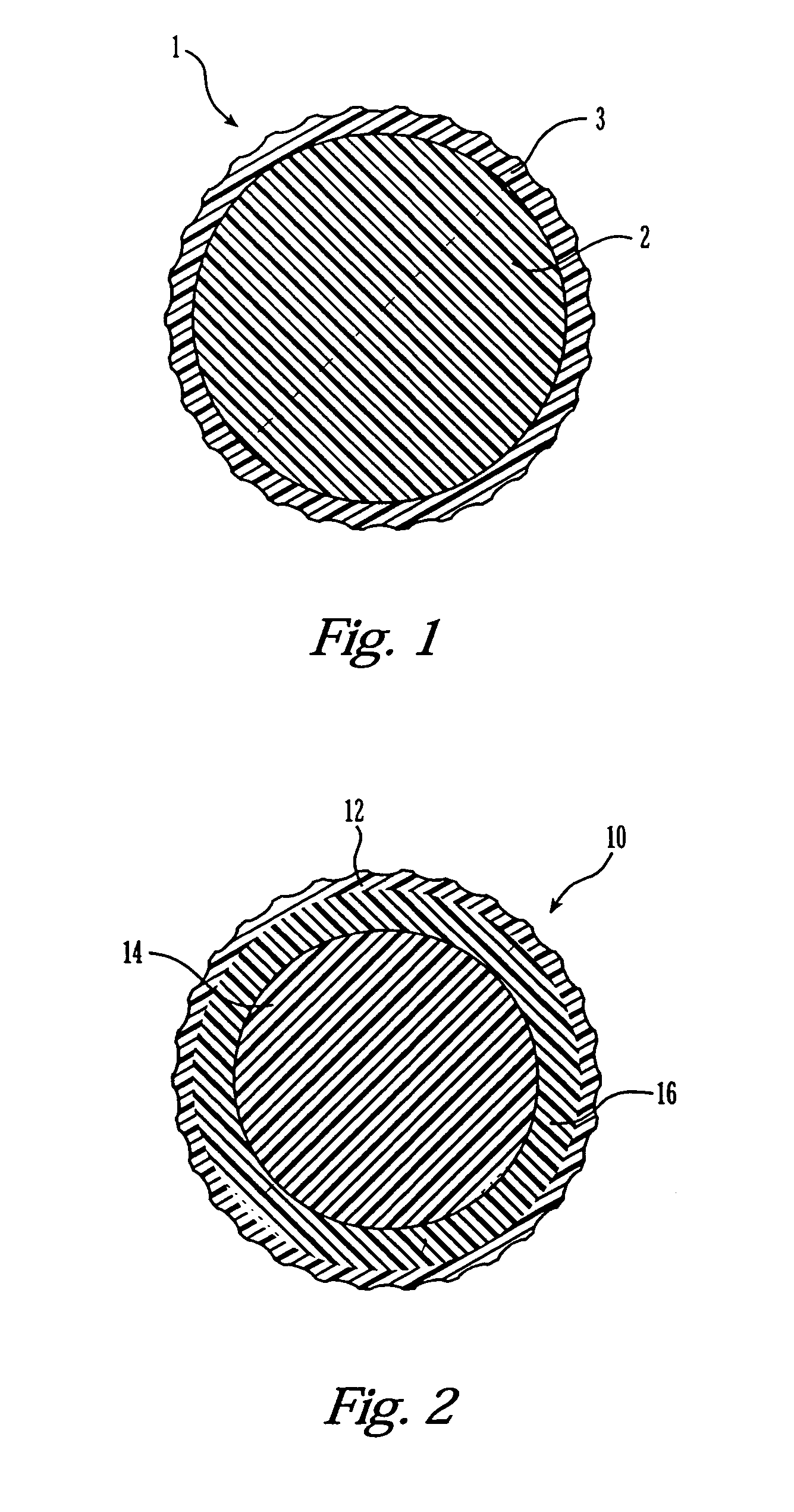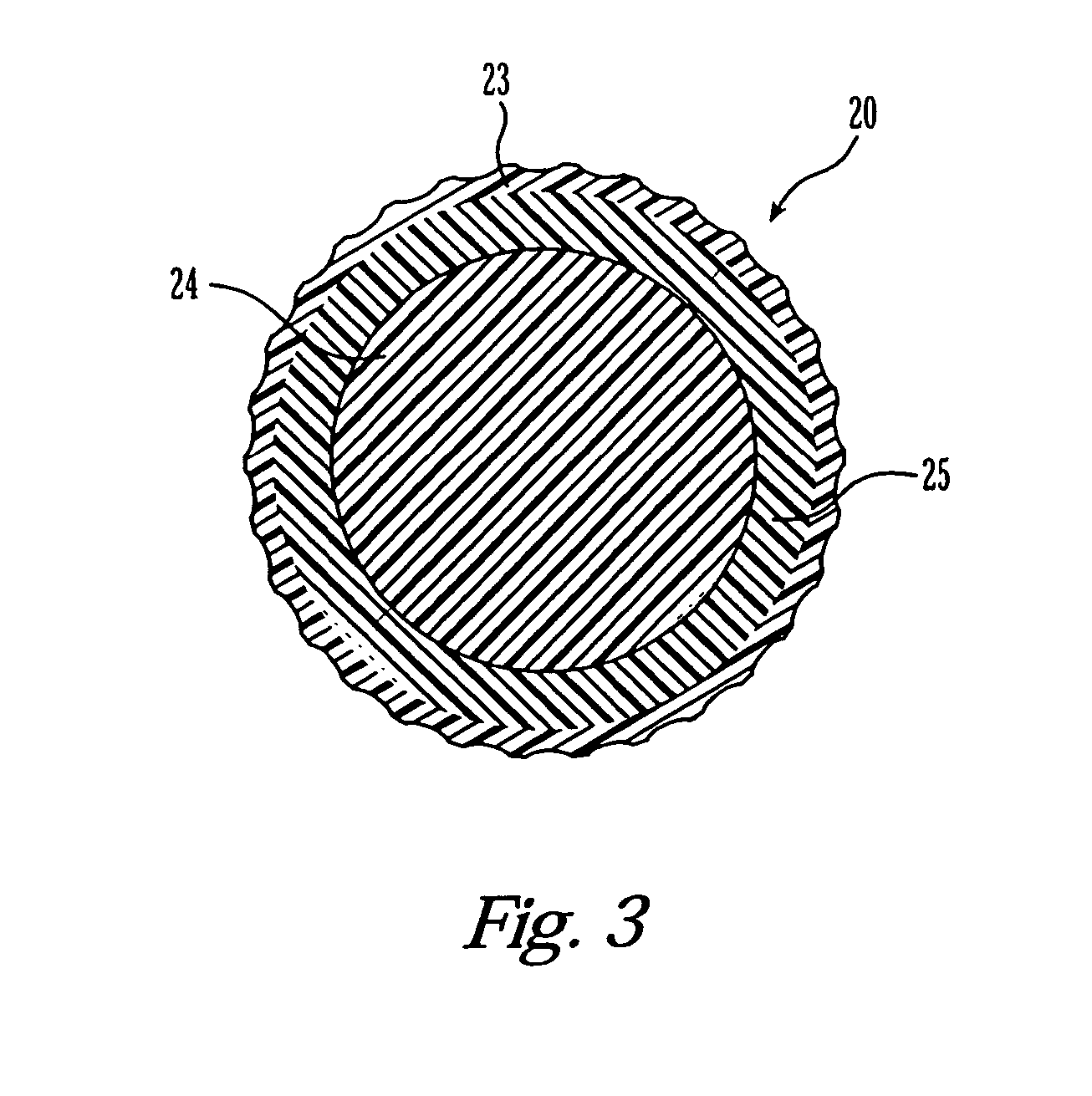Golf balls having a cover layer formed from an ionomer and metallocene-catalyzed polyolefin blend and methods of making same
- Summary
- Abstract
- Description
- Claims
- Application Information
AI Technical Summary
Benefits of technology
Problems solved by technology
Method used
Image
Examples
examples
[0167]These and other aspects of the present invention may be more fully understood by reference to the following examples. While these examples are meant to be illustrative of golf balls made according to the present invention, the present invention is not meant to be limited by the following examples. All parts are by weight unless otherwise specified.
examples 1 – 13
Examples 1–13
Effect of Maleic-Anhydride-Grafted Metallocene Cover Blends on Ball Properties.
[0168]As shown in Table 1, batches of 10 to 15 dozen golf balls were prepared having covers incorporating blends of SURLYN® 7940, a copolymer of ethylene and about 14 to 16 percent methacrylic acid, having about 30 to 60 percent of the acid groups neutralized with lithium, and a Shore D hardness of about 68, blended with one of EXACT® 4033-MA, a maleic anhydride grafted ethylene-butene metallocene-catalyzed polymer, ENGAGED 8180-MA, a maleic anhydride grafted ethylene-octene metallocene-catalyzed polymer, EXACT® 4049 an unfunctionalized ethylene-butene metallocene-catalyzed polymer, ENGAGE® 8180, an unfunctionalized ethylene-octene metallocene-catalyzed polymer, and SURLYN® 8320, a very low modulus ionomer (“VLMI”), ie., a terpolymer of ethylene, 8 to 11 percent methacrylic acid, and n-butyl acrylate, having about 40 to 60 percent of the acid groups neutralized with sodium and a Shore D hardn...
examples 14 – 15
Examples 14–15
Golf Ball Cover Prepared According to the Present Invention Compared to Conventional Cover.
[0171]As shown in Table 2, two blends were prepared. Example 14 includes: (a) SURLYN® 7940, a copolymer of ethylene and up to about 15 percent methacrylic acid, having about 40 to 60 percent of the acid groups neutralized with lithium; (b) SURLYN® 8945, a copolymer of ethylene, about 15 percent methacrylic acid, having about 20 to 40 percent of the acid groups neutralized with sodium; (c) SURLYN® NMO 525D, a maleic anhydride grafted ethylene-butene metallocene-catalyzed polymer; and (d) TiO2 concentrate dispersed in SURLYN® carrier resin containing 9–11 % methacrylic acid partially neutralized with sodium ion. Example 15 includes: (a) SURLYN® 7940; (b) SURLYN(D 8945; (c) NUCREL® 960, a non-ionomeric ethylene-methacrylic acid polymer having about 10 percent acid groups; (d) SURLYN® NMO 525D, maleic anhydride grafted ethylene-butene metallocene-catalyzed polymer; and (e) TiO2 conce...
PUM
| Property | Measurement | Unit |
|---|---|---|
| Fraction | aaaaa | aaaaa |
| Percent by mass | aaaaa | aaaaa |
| Temperature | aaaaa | aaaaa |
Abstract
Description
Claims
Application Information
 Login to View More
Login to View More - R&D Engineer
- R&D Manager
- IP Professional
- Industry Leading Data Capabilities
- Powerful AI technology
- Patent DNA Extraction
Browse by: Latest US Patents, China's latest patents, Technical Efficacy Thesaurus, Application Domain, Technology Topic, Popular Technical Reports.
© 2024 PatSnap. All rights reserved.Legal|Privacy policy|Modern Slavery Act Transparency Statement|Sitemap|About US| Contact US: help@patsnap.com










